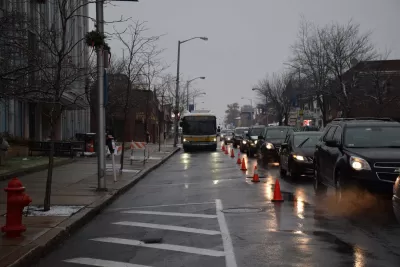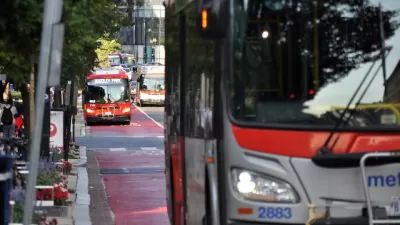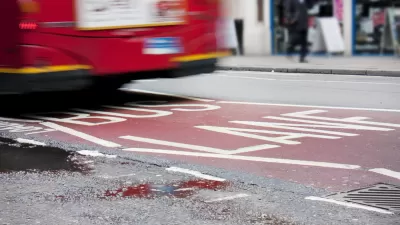The semi-legal world of quick, informal city improvements called tactical urbanism is finding a home inside transit departments.

Interested citizens will sometimes intervene to solve small neighborhood problems, like repainting a faded crosswalk or placing wayfinding signs on lamp posts. The practice has been called "tactical urbanism" and it offers the advantage of taking small actions to solve problems that cities, slowed by bureaucracy or competing interests, can be slow to address. Some transit agencies, seeing the beneficial effects of such actions, are adopting similar tactics. They’re looking for small quick fixes that can be implemented and tested at low costs.
Among other examples, a post on the TransitCenter website cites an activation from New York City: "Recently, the city expanded its 'quick delivery' repertoire for bus corridors with a rubber bus bulb-out or curb extension along the Utica Avenue corridor rather than traditional cement." Another bus project was laid out with the help of some orange cones, "In Everett, Massachusetts, a pilot project recently transformed a parking lane in a heavily congested portion of Broadway/Route 99 into bus-only lane during rush hour." Some city problems need huge spending and coordinated efforts to solve, but many don't, and nimble departments may be able find many ways to help communities.
FULL STORY: Why Tactical Transit is the Next Big Thing

Alabama: Trump Terminates Settlements for Black Communities Harmed By Raw Sewage
Trump deemed the landmark civil rights agreement “illegal DEI and environmental justice policy.”

Planetizen Federal Action Tracker
A weekly monitor of how Trump’s orders and actions are impacting planners and planning in America.

The 120 Year Old Tiny Home Villages That Sheltered San Francisco’s Earthquake Refugees
More than a century ago, San Francisco mobilized to house thousands of residents displaced by the 1906 earthquake. Could their strategy offer a model for the present?

In Both Crashes and Crime, Public Transportation is Far Safer than Driving
Contrary to popular assumptions, public transportation has far lower crash and crime rates than automobile travel. For safer communities, improve and encourage transit travel.

Report: Zoning Reforms Should Complement Nashville’s Ambitious Transit Plan
Without reform, restrictive zoning codes will limit the impact of the city’s planned transit expansion and could exclude some of the residents who depend on transit the most.

Judge Orders Release of Frozen IRA, IIJA Funding
The decision is a victory for environmental groups who charged that freezing funds for critical infrastructure and disaster response programs caused “real and irreparable harm” to communities.
Urban Design for Planners 1: Software Tools
This six-course series explores essential urban design concepts using open source software and equips planners with the tools they need to participate fully in the urban design process.
Planning for Universal Design
Learn the tools for implementing Universal Design in planning regulations.
Clanton & Associates, Inc.
Jessamine County Fiscal Court
Institute for Housing and Urban Development Studies (IHS)
City of Grandview
Harvard GSD Executive Education
Toledo-Lucas County Plan Commissions
Salt Lake City
NYU Wagner Graduate School of Public Service




























